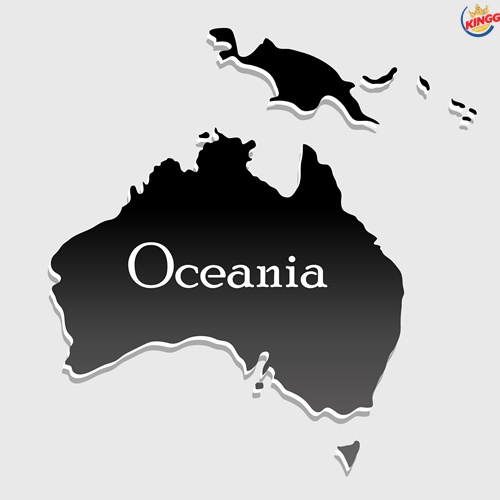Oceania is a geographically diverse region of the world with a wide range of countries and territories, primarily located in the Pacific Ocean. Oceania can be divided into several subregions and include countries, island states and territories. Here is a list of some of the countries and regions in Oceania:
Technical card on the most important countries of the continent of Oceania
Australia:
The largest and most populous country in Oceania, Australia occupies the mainland of the Australian continent and is surrounded by many islands.
New Zealand:
New Zealand is located southeast of Australia, and consists of two main islands, the North Island and the South Island, along with several small islands.
Papua New Guinea:
Located in the southwestern Pacific Ocean, Papua New Guinea is known for its cultural diversity and rugged landscapes.
Fiji:
Island nation in the South Pacific, Fiji is a popular tourist destination known for its beautiful beaches and vibrant coral reefs.
Solomon Islands: This country consists of a group of islands located in the southwest of the Pacific Ocean, characterized by its diverse cultures and amazing natural beauty.
Vanuatu:
An archipelago in the South Pacific, Vanuatu is known for its active volcanoes and unique tribal cultures.
Tonga:
Tonga is a Polynesian kingdom consisting of several islands in the South Pacific.
Samoa:
Located in the middle of the Pacific Ocean, Samoa is another Polynesian country with a rich cultural heritage.
Tuvalu: Tuvalu is a small island nation located in the middle of the Pacific Ocean, famous as one of the lowest countries in the world.
Kiribati: Kiribati is an island nation spread across the Central Pacific Ocean and consists of 33 atolls and atolls.
Marshall Islands:
This country is an island nation in the central Pacific Ocean, consisting of atolls and atolls.
Palau:
Palau is an island nation located in the western Pacific Ocean, famous for its beautiful marine environments and coral reefs.
Federated States of Micronesia:
This country is located in the western Pacific Ocean and includes four states: Yap, Chuk, Pohnpei, and Kosrae.
Nauru:
One of the smallest countries in the world, Nauru is a small island nation located in the middle of the Pacific Ocean.
French Polynesia:
An overseas group belonging to France, French Polynesia includes Tahiti, Bora Bora and many other islands in the South Pacific.
New Caledonia:
Another overseas agglomeration of France, New Caledonia is located in the southwestern Pacific Ocean and includes the main island of Grand Terre.
Wallis and Futuna:
Another French overseas grouping in the South Pacific.
Norfolk Island: An offshore territory of Australia, Norfolk Island is located in the South Pacific Ocean.
These are some of the major countries and regions of Oceania, but there are many islands and territories in the Pacific that contribute to the rich diversity of the Oceania region.
Geography
The continent of Oceania stretches across a wide area of the Pacific Ocean and includes many large and small islands. The most important islands on this continent are:
Australia: Australia is the largest country in Oceania in terms of area and population. It is located in Southeast Asia and is famous for its diverse topography and rich natural wealth.
New Zealand: It is located southeast of Australia and consists of the main northern and southern islands. New Zealand is considered one of the most beautiful tourist destinations in the world.
Pacific Islands: These islands include the Hawaiian Islands, Fiji, Tahiti, the Solomon Islands, and many other small islands scattered in the Pacific Ocean.
History
The history of Oceania is rich and diverse. Here are some key points:
Human migration: Evidence suggests that Oceania has experienced human migration for more than 40,000 years. Groups of ancient humans moved from Asia to this region via land bridges and boats.
European colonialism: In recent centuries, European settlers have begun to explore and colonize the region. Australia and New Zealand experienced European colonization and became part of British empires.
Independence and independent development: Later, most of Oceania gained independence and became independent states. These countries have evolved into countries with independent governments and thriving economies.
Cultures and languages
Oceania is a place of diverse and diverse cultures. The indigenous people of the region form diverse and diverse groups and have a unique history and traditions. In addition to the indigenous population, the region was influenced by European and Asian migrations, resulting in a great diversity of languages and cultures.
English is the official language of Australia and New Zealand, while a mix of indigenous and regional languages is spoken in the rest of the regions. Local cultures include traditional arts, music, literature, customs and traditions that reflect the heritage of these diverse communities.
Economy
Oceania's economy is diversified and relies on multiple sources. Many countries in the region rely on agriculture, industry, and services. Australia and New Zealand are two of the region's largest economies and are experiencing rapid economic growth.
Environment & Nature
Oceania is famous for its natural beauty and stunning views. The area has waterfalls, beaches, forests and wonderful marine life. The unique wild environment in the area makes it home to many rare and endangered species.
Conclusion
The continent of Oceania is a diverse and beautiful region that includes a variety of islands and countries. Its unique history, cultures and environment make it an exciting place to explore and enjoy the natural beauty and cultural diversity it offers. Oceania is one of the natural and cultural gems of our world.

